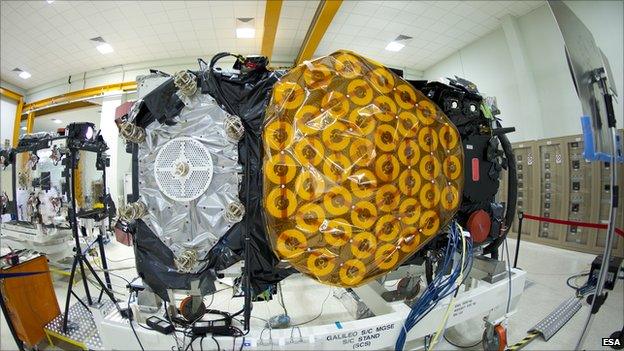Europe's Galileo sat-nav spacecraft ready to fly
- Published

The first Galileo satellites will fly to orbit on a Russian rocket from French Guiana
Europe's first two Galileo satellite-navigation spacecraft are ready for launch.
The platforms passed a key technical review at the weekend, paving the way for their flight to orbit on a Russian Soyuz rocket on 20 October.
One satellite has already made the journey to the launch complex in French Guiana; the second will ship this week.
The European Commission is investing billions of euros in its own version of the American GPS system.
It expects Galileo to bring significant returns to the 27-nation bloc's economies in the form of new businesses that can exploit precise timing and location data delivered from space.
The first two satellites are pathfinders for the system as a whole. Together with another pair of spacecraft to be lofted next year, they will validate the entire Galileo system, proving that it works as designed. Consumers should begin using Galileo alongside GPS in 2015.
On Saturday, the EC's technical agent, the European Space Agency (Esa), formally took delivery of the first satellites from industry in the shape of a paper exercise known as a qualification acceptance review.
"Qualification means the satellites have successfully passed all tests and are considered ready to fly and support the intended mission in orbit over the 12-year lifetime," Esa's Galileo project manager Javier Benedicto told 大象传媒 News.
Both satellites are being transferred to the brand new Sinnamary spaceport in French Guiana, the new home for commercial Soyuz launches.
This facility is just north of the Kourou base traditionally used by Europe's workhorse launcher, the Ariane 5.
In the coming weeks, the Galileo pair will undergo final checks, which will see their flight software loaded and their propulsion sub-systems being fuelled. The last task will be to mate the duo to their Soyuz ST-B rocket. The launcher will put the satellies in a medium-altitude orbit some 23,000km above the planet.
The In-Orbit Validation (IOV) spacecraft have been built by a consortium, including Europe's two heavyweight space companies - Astrium and Thales Alenia Space.
Astrium's role, at its UK centre in Portsmouth, was to integrate all the payload components, including hydrogen-maser atomic clocks, the ultra-precise time-pieces on which Galileo's performance depends.
It will be the first flight of Soyuz from its new Sinnamary base in South America
Astrium satellites CEO Evert Dudok told 大象传媒 News: "With the qualification acceptance review done, it means the satellites are now in Esa's hands - although of course we will be supporting the launch preparation.
"This, if you like, finishes the development programme of Galileo; and with the launch next year of the third and fourth satellites, the in-orbit verification will start.
"With these satellites, Europe masters navigation technologies, at least to the level of the US - and since Galileo has a more modern signal structure, I personally think we are a little bit ahead of the US."
Galileo should have been operational by now but the project has run into myriad technical, commercial and political obstacles, including early objections from the US, who thought a rival system to GPS might be used to attack its armed forces.
The venture came very close to being abandoned in 2007 when the public-private partnership put in place to build and run the project collapsed.
To keep Galileo alive, EU member-states had to agree to fund the entire project from the public purse. What should have cost European taxpayers no more than 1.8bn euros will now probably cost them in excess of 5bn euros.
The EU's continued commitment to the project despite severe budgetary and management failings is based on the belief that huge returns to the European economy will accrue from the investment.
Already, GPS is said to have spawned global markets that are worth several tens of billions of euros annually.
The new European constellation is expected to deepen and extend those markets as sat-nav functionality becomes ubiquitous in consumer devices such as mobile phones.
- Published22 June 2011
- Published8 March 2011
- Published3 March 2011
- Published18 January 2011
- Published26 October 2010
- Published17 January 2011